Lacto-fermented radishes are tart and tangy, crunchy and fresh… perfect on green salads or dipped in our favorite homemade ranch dressing. If you’re new to fermentation, this easy gut-friendly recipe will get you started!
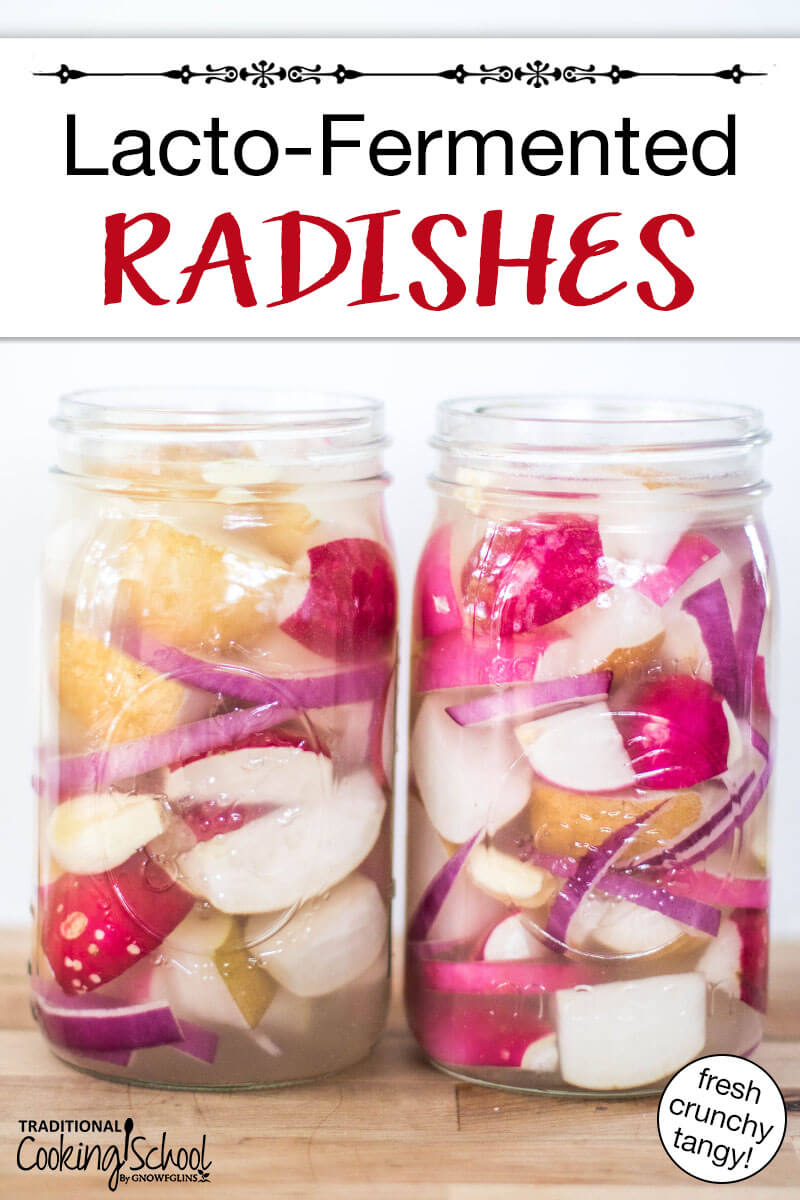
Have you ever eaten something so good that you’re scraping the bottom of the jar before you know it?
These naturally pickled, lacto-fermented radishes are just like that!
The brine, if beginning with red radishes, is just about the prettiest I’ve seen. And the nutrition? Can’t be beat.
Supplies Needed
You can invest in fermenting crocks, fermenting weights, airlock lids, etc. if you would like. But this is all you really need!
- Glass jars – You will need quart-sized glass Mason jars, preferably wide mouth although regular mouth jars will work in a pinch.
- Metal bands and lids – For covering the jar(s) of radishes as they ferment.
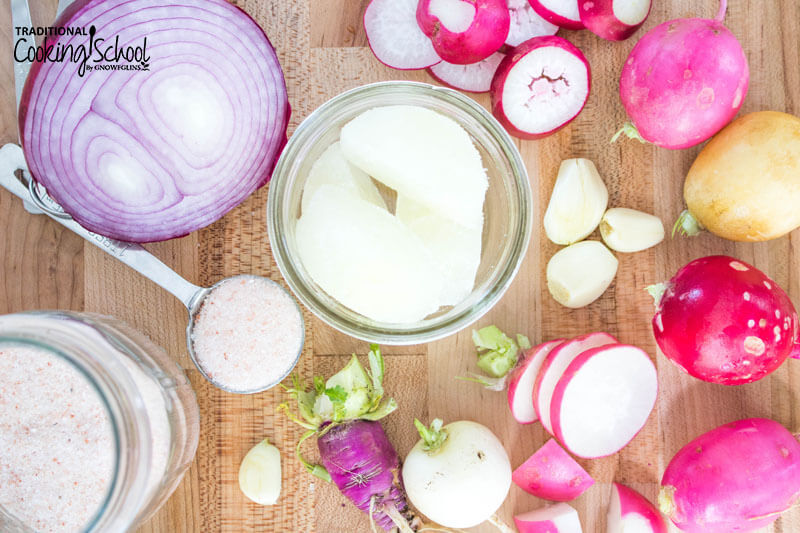
Ingredients
- Radishes – Organic and/or local, if possible.
- Sea salt – Choose a high-quality, fine-grain, mineral-rich salt. Don’t use store-bought, commercial iodized salt. Salt is not optional since it protects the fermenting foods from putrefying bacteria while allowing the beneficial bacteria necessary for proper fermentation to thrive. It’s essential, in the amount written below, for safe fermentation.
- Pure water – Use mineral-rich, chlorine-free water rather than contaminated well water or straight city water which may contain chlorine, chloramine, and/or flouride, etc. Mixing chlorinated water with cultures can affect your lacto-fermentation recipes. If your water is not clean or you don’t filter it, I recommend purchasing spring water or filtered water (here’s how to choose the best water filter for your family!). If your water is filtered and does not re-add minerals back, consider fortifying it with natural mineral drops. I discuss using reverse osmosis water for fermenting in this #AskWardee.
- Whey – Although optional, the use of whey in ferments kickstarts fermentation and helps ensure consistent results. Learn how to make whey here. If you’re dairy-free, you can use leftover fermenting juice from pickles or sauerkraut instead at the same rate as whey.
Flavor Options
Mix and match the below spices and herbs to come up with your dream flavor combination!
- Garlic – 2 to 3 whole crushed cloves per quart.
- Onion – 1/4 red onion, thinly sliced, per quart.
- Pepper – 1 teaspoon whole peppercorns per quart.
- Ginger – 1 inch chopped ginger root per quart.
- Coriander – 1/2 teaspoon coriander per quart.
- Mustard – 1/2 teaspoon mustard powder per quart.
- Bay leaf – 1 bay leaf per quart.
- Dill – 1 teaspoon dried dill seed per quart.
Directions
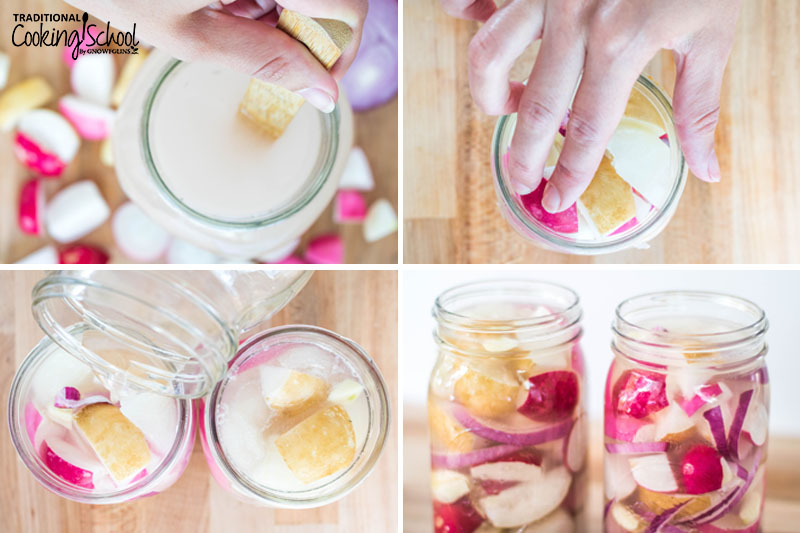
- Make your brine by dissolving salt in water. Simply combine salt and water in a half-gallon jar and stir until the salt dissolves.
- Prep veggies: Chop ends off radishes chop into quarters (small radishes) or sixths (large radishes). Thinly slice onions. Peel and crush garlic cloves.
- Fill as many quart jars as necessary to use up all prepared vegetables. Pack radishes alternately with onion and garlic.
- Press down on the veggies to make sure they’re packed in well but leave an inch of headspace at the top of the jar.
- Pour brine and whey, if using, over top.
- Use a clean regular mouth jar lid to weigh down radishes below surface of liquid (otherwise they like to float up to the top).
- Put the lids and bands on the jars and tighten securely.
- Leave on the counter at room temperature for 3 to 5 days. Look for bubbles as a sign that fermentation is happening (if you don’t see bubbles, read my tips below). Taste periodically until you achieve your desired flavor. Skim off any mold that accumulates on the surface (see my tips for troubleshooting mold below).
- When done, transfer to the refrigerator or cool storage.
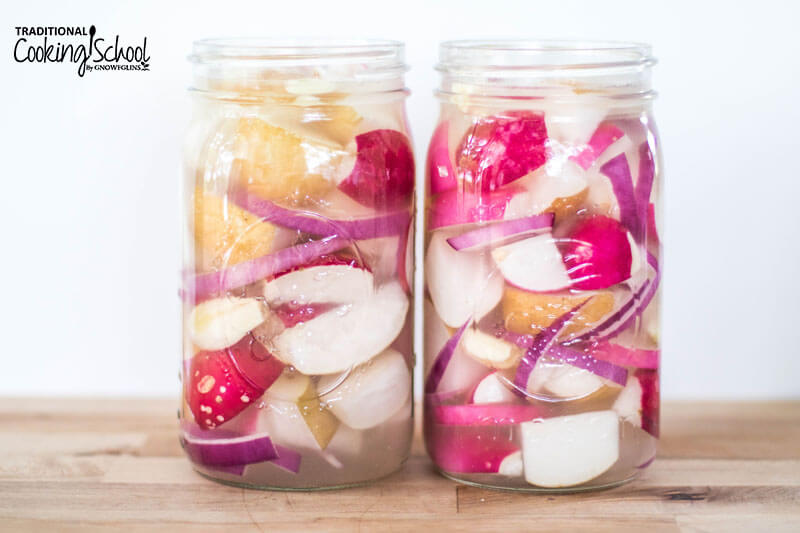
Frequently Asked Questions: Tips & Tricks
What type of radishes can I ferment?
Any kind. I have used just plain red radishes, and an Easter egg mix of radishes (pictured). They all work!
I’m dairy-free. Is there another starter culture I can use instead of whey?
Yes! You can use leftover fermenting juice from pickles or sauerkraut instead at the same rate as whey.
Help! I don’t see any bubbles in my fermented radishes.
Look for other signs of the fermentation process, such as texture changes, color changes and the whole mixture starting to develop sourness from the lactic acid that’s produced. If you’re seeing these signs, all is well. If you’re not, is your ferment kept in a warm enough place to allow the beneficial bacteria to thrive?
I think I see mold in/on my fermented radishes. Is it safe to eat if I skim it away, or should I toss the whole thing?
It depends. Please reference this post for preventing mold during fermentation, and what to do if it happens.
How can I tell if my radish pickles are spoiled or not?
Trust your nose! Though be aware that if it repels you but is not spoiled, it might be because you’re unaccustomed to fermented foods and need time to adjust to a new normal. If you aren’t sure, you can take a little taste and see how it goes. It’s always okay to be on the safe side and compost the ferment or feed the chickens with it and start again.
Check out this #AskWardee for the signs that your ferment is on the right track. And here are hard and fast signs that a ferment has gone wrong:
- It’s moldy. Pink or fuzzy is not good.
- It’s mushy.
- Its smell repels you because it’s putrid or rotten, not just sour. Your nose KNOWS this!
- When you taste it, it gives you an upset stomach. (Don’t confuse this with a healing reaction, though.)
Any time you get into a jar, repack it carefully to keep all food submerged and under the protection of the brine.
How can I tell if my fermented radishes are done?
Go ahead and open a jar up to smell and taste it! No two ferments are going to be exactly alike — this is a flexible process and you really have to open the jar and dig in to see what’s going on in there. I discuss the typical signs of a finished ferment in this article.
How to eat fermented radishes.
I personally love eating pickled radishes straight from the jar! Also delicious, serve as part of a charcuterie board, a veggie platter with homemade ranch dressing dip, atop a green salad, or sliced thinly on a sandwich, they’re also fantastic on a hummus platter with this homemade sprouted hummus and cut up veggies. They are tart and tangy, crunchy and fresh!
Can I reuse the brine?
Definitely! Do keep in mind the flavor, however. A garlicky radish brine is probably not going to taste good inside a fruit ferment… but would be delicious in other savory fermented foods, like another batch of pickled radishes or homemade sauerkraut!
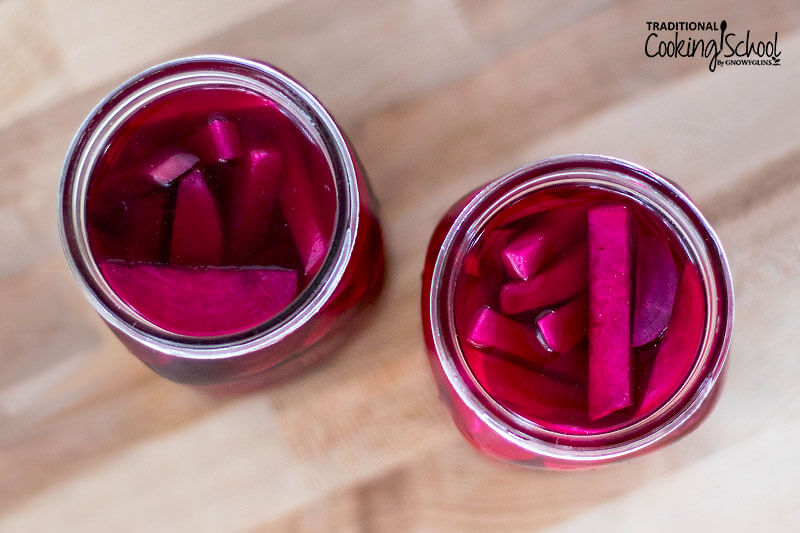
Other Fermented Recipes
Here are a few of our favorite fermented vegetables!
- Pickled Radish Pods
- Old-Fashioned, Crunchy, Fermented Garlic-Dill Pickles
- Lacto-Fermented Turnips & Beets (pictured above)
- Lacto-Fermented Carrot Sticks
- Garlic-Dill Pickled Okra (crunchy, not slimy probiotic snack!)
- Homemade Sauerkraut In A Stoneware Crock
- What Is Lacto-Fermentation? {Video}
- Fermenting Trouble Shooting FAQ’s
Did you make this recipe? Please leave a star rating in the recipe card below, then show us your finished product or your favorite way to enjoy fermented radishes and tag us on social media @tradcookschool.
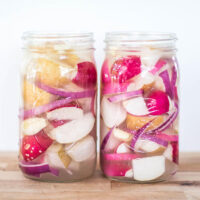
Lacto-Fermented Radishes
Equipment
- Quart-sized glass jars
- Metal bands and lids
Ingredients
- 1/2 gallon pure water
- 6 tablespoons sea salt
- radishes ends chopped off and cut into quarters
- 3 cloves garlic crushed; per quart
- 1/4 red onion sliced thinly; per quart
- 1/4 cup whey optional; per quart
Instructions
- Make your brine by dissolving salt in water. Simply combine salt and water in a half-gallon jar and stir until the salt dissolves.
- Chop ends off radishes chop into quarters (small radishes) or sixths (large radishes).
- Thinly slice onions.
- Peel and crush garlic cloves.
- Fill as many quart jars as necessary to use up all prepared vegetables, layering radishes with onion and garlic.
- Press down on the veggies to make sure they’re packed in well and don’t fill up higher than within 1 inch of the top.
- Pour whey, if using, and brine over top.
- Use a clean regular mouth jar lid to weigh down radishes below surface of liquid (otherwise they like to float up to the top).
- Put the lids and bands on the jars and tighten securely.
- Leave on the counter at room temperature for 3 to 5 days. Look for bubbles as a sign that fermentation is happening (if you don't see bubbles, read my tips below). Taste to see where you like the texture and taste.
- Skim off any mold that accumulates on the surface.
- When done, transfer to the refrigerator or cool storage.
Notes
Nutrition
This post was originally published and written by Wardee Harmon on 5/17/11. It was updated and republished on 7/7/21.
This post was featured in 37 Ferments for Spring.
The post How To Make Lacto-Fermented Radishes appeared first on Traditional Cooking School by GNOWFGLINS.